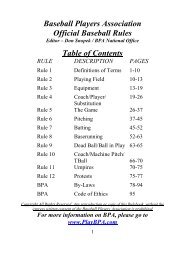baseball players association rule 1 definitions of terms
baseball players association rule 1 definitions of terms
baseball players association rule 1 definitions of terms
You also want an ePaper? Increase the reach of your titles
YUMPU automatically turns print PDFs into web optimized ePapers that Google loves.
SECTION 3<br />
SECTION 4<br />
SECTION 5<br />
From the windup position, the pitcher may:<br />
a.) Deliver the ball to the batter.<br />
b.) Step and throw to a base in an attempt to pick-<strong>of</strong>f a runner.<br />
c.) Disengage the rubber. (If he does, he must drop his hands to his sides).<br />
*NOTE. In disengaging the rubber, the pitcher must step <strong>of</strong>f with his pivot foot and not his free foot<br />
first. It is considered a balk if the pitcher goes into a set or stretch position.<br />
THE SET POSITION<br />
a.) The pitcher shall indicate the set position when he stands facing the batter with his entire pivot foot on,<br />
or in front <strong>of</strong>, and in contact with, and not <strong>of</strong>f the end <strong>of</strong> the pitcher’s rubber, and his other foot in front<br />
<strong>of</strong> the pitcher’s rubber, holding the ball in both hands in front <strong>of</strong> his body and coming to a complete stop.<br />
b.) From this set position he may deliver the ball to the batter, throw to a base or step backward <strong>of</strong>f the<br />
pitcher’s rubber with his pivot foot.<br />
c.) Before assuming set position, the pitcher may elect to make any natural preliminary motion such as that<br />
known as the “stretch”. If he so elects, the pitcher shall come to set position before delivering the ball<br />
to the batter.<br />
d.) After assuming the set position, any natural motion associated with his delivery <strong>of</strong> the ball to the batter<br />
commits him to the pitch without alteration or interruption.<br />
e.) Preparatory to coming to a set position, the pitcher shall have one hand on his side, from this position<br />
he shall go to his set position, without interruption and in one continuous motion.<br />
f.) The whole width <strong>of</strong> the foot in contact with the rubber must be on the rubber. A pitcher cannot pitch<br />
from <strong>of</strong>f the end <strong>of</strong> the rubber with just the side <strong>of</strong> his foot touching the rubber.<br />
g.) The pitcher following his stretch must:<br />
1.) Hold the ball in both hands in front <strong>of</strong> his body.<br />
2.) Come to a complete stop.<br />
*NOTE. This must be enforced. Umpires should watch this closely. Pitchers are constantly<br />
attempting to “beat the <strong>rule</strong>” in their efforts to hold runners on bases and in cases where the pitcher<br />
fails to make a complete “stop” as called for in the <strong>rule</strong>s, the umpire should immediately call a<br />
“balk”.<br />
h.) At any time during the pitcher’s preliminary movements and until his natural pitching motion commits<br />
him to the pitch, he may throw to any base provided he steps directly toward the base before making the<br />
throw.<br />
*NOTE. The pitcher shall step “ahead <strong>of</strong> the throw”. A snap throw followed by the step directly<br />
toward the base, is a “balk”.<br />
i.) If the pitcher makes an illegal pitch with the bases unoccupied, it shall be called a ball, unless the batter<br />
reaches first base on a hit, error, base on ball, a hit batter or otherwise.<br />
*NOTE. A ball that slips out <strong>of</strong> a pitcher’s hand and crosses the foul line shall be called a ball;<br />
otherwise it will be called no pitch. This would be a balk with runners on base.<br />
j.) If the pitcher removes his pivot foot from contact with the pitching rubber by stepping backward with<br />
that foot, he thereby becomes an infielder and if he<br />
makes a wild throw from that position; it shall be considered the same as a wild throw by an other<br />
infielder.<br />
*NOTE. The pitcher while <strong>of</strong>f the rubber may throw to any base. If he makes a wild throw, such throw<br />
is the throw <strong>of</strong> an infielder and what follows is governed by the <strong>rule</strong>s covering a ball thrown by a<br />
fielder.<br />
The pitcher shall not:<br />
a.) Bring his pitching hand in contact with his mouth or lips while on the pitching mound.<br />
*EXCEPTION. Provided both managers agree to, the umpire prior to the start <strong>of</strong> the game played in<br />
cold weather may permit the pitcher to blow on his hand.<br />
*PENALTY. For violation <strong>of</strong> this <strong>rule</strong>, the umpire shall immediately call a balk the ball immediately<br />
becoming dead and a ball will be awarded to the batter if there are no runners on base. If there are<br />
runner(s) on base, runner(s) shall advance one base.<br />
b.) Apply a foreign substance <strong>of</strong> any kind to the ball.<br />
c.) Expectorate (spit) on the ball, and either his hand or his glove.<br />
d.) Rub the ball on his glove, person, clothing or the ground.<br />
e.) Deface the ball in any manner.<br />
f.) Deliver what is called a “spit’, “mud”, or “emery” ball.<br />
*NOTE. The pitcher, <strong>of</strong> course, is allowed to rub the ball between his bare hands.<br />
*PENALTY. Violation <strong>of</strong> <strong>rule</strong>s b-f, the umpire shall:<br />
1.) Call the pitch a ball, warn the pitcher, and explain to the coaches.<br />
19



